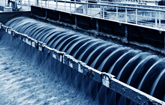PVC Pipe Has Lowest Break Rate, Corrosion a Problem for 75% of Water Utilities According to a Comprehensive Study from Utah State University
LOGAN, Utah, April 19, 2012 /PRNewswire/ -- The Utah State University (USU) Buried Structures Laboratory has published a comprehensive study on water main break rates for the United States and Canada. USU, located in Logan, Utah is also home to the Utah Water Research Laboratory and has significantly contributed to water and wastewater research internationally for the last 50 years. The Buried Structures Laboratory is one of two locations in the United States that has a large scale testing facility for pipe materials and structures.
Dr. Steven Folkman, co-author of Buried Pipe Design, has completed the pipe materials study in which 188 utilities representing approximately 10% of the nation's installed water main pipe network responded. Water main break rates are calculated for all pipe materials used in the transport of water to create a measurement to judge pipe performance and durability. The study will help prudent decision-making as it relates to repairing and replacing underground pipes.
A major finding of the study is that PVC pipe has the lowest overall failure rate when compared to cast iron, ductile iron, concrete, steel and asbestos cement pipes. Another major finding includes corrosion is a major cause of water main breaks: 75% of all utilities have corrosive soil conditions and combined with a high portion of old cast iron and ductile iron pipes, corrosion is ranked the second highest reason for water main pipe failure in the United States. When comparing between older cast iron and newer ductile iron, thinner-walled ductile iron is experiencing failures more rapidly.
Other findings include a new national metric of 264 people per 1 mile of pipe connections regardless of utility size. The average age of the failing water mains is 47 years old and 22% of all water mains are over 50 years old. The study also found that 8% of all installed water mains are beyond their useful life and the use of trenchless technologies will continue to increase with directional drilling as the most widely accepted technology with a higher satisfaction rating and 74% of utilities are considering it in the near future. This study contributes to the continuing efforts of the EPA's Aging Water Infrastructure (AWI) research and the American Water Works Association (AWWA).
The Water Main Break Rates In the USA and Canada: A Comprehensive Study can be found at:
http://www.neng.usu.edu/mae/faculty/stevef/UtahStateWaterBreakRatesHR.pdf (High resolution)
http://www.neng.usu.edu/mae/faculty/stevef/UtahStateWaterBreakRatesLR.pdf (Low resolution)
Dr. Steven Folkman is a registered Professional Engineer, a member of American Society for Testing and Materials (ASTM) F17 Plastic Piping Systems, a member of AWWA and a member of the Transportation Research Board Committee on Culverts and Hydraulic Structures, and has oversight of the prestigious Utah State University's Buried Structures Laboratory (USU - BSL). USU - BSL has been involved in analysis and testing of all kinds of pipe and associated structures for over 50 years and is recognized as one of two laboratories in the U.S for performing large scale tests on buried pipes. Dr. Folkman's expertise includes structural dynamics, linear and nonlinear finite element analysis utilizing soil/structure interaction, and testing.
SOURCE Utah State University
WANT YOUR COMPANY'S NEWS FEATURED ON PRNEWSWIRE.COM?
Newsrooms &
Influencers
Digital Media
Outlets
Journalists
Opted In





Share this article